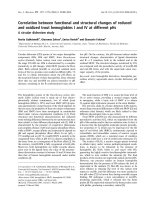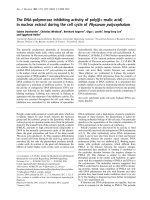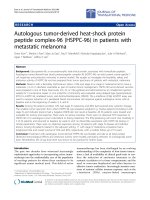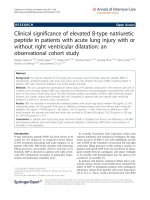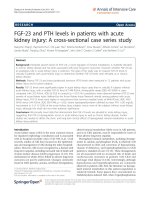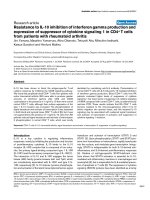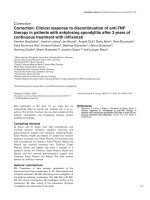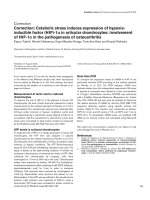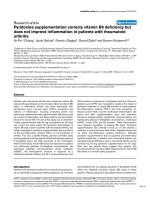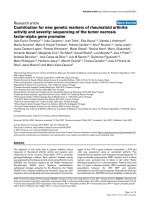Báo cáo y học: "Correlation between parameters at initiation of renal replacement therapy and outcome in patients with acute kidney injury" ppsx
Bạn đang xem bản rút gọn của tài liệu. Xem và tải ngay bản đầy đủ của tài liệu tại đây (152.27 KB, 13 trang )
Open Access
Available online />Page 1 of 13
(page number not for citation purposes)
Vol 13 No 6
Research
Correlation between parameters at initiation of renal replacement
therapy and outcome in patients with acute kidney injury
Marlies Ostermann
1
and René WS Chang
2
1
Department of Critical Care, Guy's & St Thomas' Foundation Hospital, Westminster Bridge Road, SE1 7EH, UK
2
Department of Nephrology & Transplantation, St George's Hospital, Blackshaw Road, SW17 0QT, UK
Corresponding author: Marlies Ostermann,
Received: 17 Aug 2009 Revisions requested: 7 Oct 2009 Revisions received: 26 Oct 2009 Accepted: 4 Nov 2009 Published: 4 Nov 2009
Critical Care 2009, 13:R175 (doi:10.1186/cc8154)
This article is online at: />© 2009 Ostermann and Chang et al.; licensee BioMed Central Ltd.
This is an open access article distributed under the terms of the Creative Commons Attribution License ( />),
which permits unrestricted use, distribution, and reproduction in any medium, provided the original work is properly cited.
Abstract
Introduction Renal replacement therapy (RRT) is a fully
established treatment for critically ill patients with acute kidney
injury (AKI) but there are no scientifically established criteria
when to initiate it. Our objectives were to describe the
epidemiology of critically ill patients with AKI receiving RRT and
to evaluate the relationship between biochemical, physiological
and comorbid factors at time of RRT and ICU mortality.
Methods Retrospective analysis of demographic and
physiologic data of 1,847 patients who received RRT for AKI in
22 ICUs in UK and Germany between 1989 - 1999.
Results 54.1% of RRT patients died in ICU. ICU survivors were
younger, had a lower APACHE II score and fewer failed organ
systems on admission to ICU compared to non-survivors.
Multivariate analysis showed that at time of initiation of RRT,
independent risk factors for ICU mortality were mechanical
ventilation [odds ratio (OR) 6.03], neurological failure (OR
2.48), liver failure (OR 2.44), gastrointestinal failure (OR 2.04),
pre-existing chronic illnesses (OR 1.74), haematological failure
(OR 1.74), respiratory failure (OR 1.62), oligoanuria (OR 1.6),
age (OR 1.03), serum urea (OR 1.004) and cardiovascular
failure (OR 1.3). A higher pH at initiation of RRT was
independently associated with a better outcome. Failure to
correct acidosis and development of more organ failure within
48 hours after initiation of RRT were also associated with an
increased risk of dying in ICU.
Conclusions Oligoanuria, acidosis and concomitant
dysfunction of other organs at time of RRT were associated with
poor survival. In contrast, serum creatinine and urea levels only
had a weak correlation with outcome after RRT.
Introduction
Acute kidney injury (AKI) is a common problem in hospitalised
patients with a reported incidence of between 10 and 20%
but as high as 70% in critically ill patients in the intensive care
unit (ICU) [1-4]. To date, there are no curative therapies. Man-
agement is limited to fluid and haemodynamic optimisation,
and renal replacement therapy (RRT) when necessary. Fur-
thermore, there are no robust data to accurately distinguish in
advance between injured kidneys that will need extracorporeal
support and kidneys that retain capacity for early recovery.
Although RRT has been an integral part of critical care for dec-
ades and technologies have advanced considerably, there are
no scientifically established criteria for the initiation of RRT. As
a result, the provision of renal support is very variable in clinical
practice [5-7].
The indications for RRT in critically ill patients with AKI have
generally been extrapolated from the end-stage kidney dis-
ease experience and included refractory hyperkalaemia, resist-
ant fluid overload, severe persistent metabolic acidosis, and
overt uraemic symptoms, including uraemic pericarditis and
encephalopathy. Although there is little dispute about the
necessity of RRT for these urgent indications, there is no con-
sensus on the degree of azotaemia or the duration of AKI that
warrants RRT in the absence of these 'absolute' indications
[8]. Clinical studies addressing the 'optimal' timing of RRT are
conflicting [9-12]. In a meta-analysis, Seabra and colleagues
AKI: acute kidney injury; APACHE: acute physiology and chronic health evaluation score; CI: confidence interval; HD: intermittent haemodialysis; ICU:
intensive care unit; OR: odds ratio; pCO2: partial pressure of carbon dioxide; PD: peritoneal dialysis; RRT: renal replacement therapy; SOFA: Sequen-
tial Organ Failure Assessment.
Critical Care Vol 13 No 6 Ostermann and Chang
Page 2 of 13
(page number not for citation purposes)
summarised the results of 23 studies, including four ran-
domised controlled trials, which compared the effect of "early"
versus "late" RRT on mortality in patients with AKI [12].
Despite the conclusion that early institution of RRT might have
a beneficial effect on survival, the authors emphasized that the
studies were very heterogenous and differed in quality. The dif-
ferentiation between 'early' and 'late' RRT is variable and usu-
ally based on arbitrary thresholds in traditional parameters
such as serum creatinine or urine output, time from admission
to ICU or time from diagnosis of AKI [11].
In 2006, the AKI Network assembled a multidisciplinary stake-
holder committee with representation from the 18 leading
international professional societies of critical care and nephrol-
ogy. They identified the key questions for future research in the
field of AKI in ICU [13]. Top priority was given to the broad top-
ics of epidemiology of AKI and RRT, including the quest for cri-
teria for RRT.
The objectives of this study were twofold. Firstly, to describe
the epidemiology of ICU patients treated with RRT and to
compare them with AKI stage III patients who did not receive
RRT. Secondly, in search of the optimal criteria for RRT, we
aimed to evaluate the relation between different physiological,
metabolic and comorbid factors at the time of initiation of RRT
and subsequent outcome.
Materials and methods
Study population
Using the Riyadh Intensive Care Program database with
demographic and daily physiological data of 41,972 adult
patients admitted to 19 ICUs in the UK and three ICUs in Ger-
many between June 1989 and October 1999, we analysed
the data of 1847 patients who had received RRT for AKI.
Receiving RRT is one of four criteria for the diagnosis of AKI
stage III according to the AKI network [14]. For comparison,
we identified 935 patients with AKI stage III as defined by the
creatinine criteria (ie. rise in serum creatinine to ≥ 354 μmol/L
or rise in serum creatinine by >300% from baseline within 48
hours) who were not treated with RRT.
All 22 centres included in the study were able to provide RRT
if necessary.
Data analysis
Acute severity of illness was measured using the acute physi-
ology and chronic health evaluation score (APACHE) II and
Sequential Organ Failure Assessment (SOFA) scoring sys-
tem. Organ system failures were determined according to the
criteria by Knaus and colleagues [15].
Cardiovascular failure was defined by the presence of one or
more of the following: heart rate 54 beats/min or less; mean
arterial blood pressure less than 50 mmHg; occurrence of ven-
tricular tachycardia and/or ventricular fibrillation; serum pH of
7.24 or less with a partial pressure of carbon dioxide (pCO
2
)
of 49 mmHg or less.
Respiratory failure was defined as a presence of one or more
of the following: respiratory rate of 5 breaths/min or less or 49
breaths/min or more; pCO
2
50 mmHg or more; alveolar-arte-
rial pO
2
difference of 350 mmHg or more; dependent on ven-
tilator on the fourth day of organ system failure (i.e. not
applicable for the initial 72 hours of organ system failure).
Haematological failure was defined as the presence of one or
more of the following: white blood cells of 1000 cells/mm
3
or
less; platelets of 20,000 cells/mm
3
or less; haematocrit of
20% or less.
Neurological failure was defined as Glasgow Coma Score of
6 or less (in absence of sedation). If patient is sedated and/or
paralysed, neurological scoring is not performed and patient is
not considered in neurological failure.
Hepatic failure was defined by the presence of both: bilirubin
more than 60 mg/L or a two-fold increase in serum alkaline
phosphatase; prothrombin time more than four seconds over
upper limit of normal range or a two-fold increase in serum
aspartate aminotransferase.
We also included a definition for gastrointestinal failure, which
was 'failure to tolerate enteral nutrition and need for total
parenteral nutrition' [16].
The highest number of failed organs (excluding renal failure)
on any day during the stay in the ICU was recorded as 'Maxi-
mum number of associated organ failure'.
We also recorded whether patients had evidence of any of the
following pre-existing chronic illnesses:
Cardiovascular - New York Heart Association Class IV angina
or symptoms at rest or on minimal exertion, e.g getting dressed
or self-care;
Liver - Biopsy proven cirrhosis and documented portal hyper-
tension or previous episodes of variceal bleed/liver failure/
encephalopathy;
Respiratory - Chronic restrictive, obstructive, or vascular dis-
ease resulting in severe exercise restrictions, e.g. unable to
climb stairs or documented chronic hypoxia, hypercapnea,
secondary polycythaemia, severe pulmonary hypertension
(>40 mmHg) or respiratory dependency;
Immunocompromised - Patients receiving immunosuppres-
sion, chemotherapy, radiation, long-term steroid treatment,
leukaemia, lymphoma, AIDS or widespread metastatic cancer.
Available online />Page 3 of 13
(page number not for citation purposes)
Ethics approval
The local ethics committee confirmed that Research and Eth-
ics approval was not required for this study. The need for
informed consent was also waived because the study required
neither an intervention nor breach of privacy or anonymity.
Statistical analysis
Demographic data were presented as mean ± standard devi-
ation and 95% confidence intervals (CI) or median and range.
Statistical significance was evaluated in univariate analyses
using chi-square test, Fisher's exact test and Mann-Whitney U
test. A matrix was created to illustrate the impact of combina-
tions of different physiological and biochemical factors at the
time of RRT on subsequent outcome.
Multivariate logistic regression analyses were conducted to
identify independent predictors of all-cause ICU and hospital
mortality and to obtain the odds ratios (ORs). Variables that
were found to be significant risk factors in univariate analyses
were entered simultaneously in the multivariable model (enter
method). The statistical package SPSS (Version 14.0, Wok-
ing, Surrey, UK) was used for all statistical analyses. A P <
0.05 was considered statistically significant.
Data related to ICU mortality are presented within this paper
whereas results related to hospital mortality are available as
supplementary tables in Additional data file 1 with the online
version of this paper.
Results
Patient characteristics
For AKI, 1847 patients received RRT of whom 1473 patients
(79.8%) were treated with a continuous mode alone (continu-
ous arterio-venous haemofiltration or continuous veno-venous
haemo(dia)filtration), 95 patients (5.1%) received intermittent
haemodialysis (HD) and 12 patients (0.6%) had peritoneal
dialysis (PD) alone. Two hundred and forty patients (13.0%)
were treated with a combination of a continuous mode fol-
lowed by HD. One patient had incomplete data related to the
type of RRT. ICU mortality was 54.1% and hospital mortality
was 61.6%. ICU survivors were younger and less sick on
admission to the ICU as evidenced by a significantly lower
APACHE II score and fewer failed organ systems (Table 1). In
addition, they had less pre-existing chronic illnesses. During
their stay in ICU, they needed ventilation less often and had
fewer organ failures.
RRT is one of five criteria for the diagnosis of AKI stage III and
935 patients in this study fulfilled the creatinine criteria for AKI
stage III but were not treated with RRT. Direct comparison
confirmed that patients with AKI stage III on RRT had a signif-
icantly higher ICU and hospital mortality than patients with AKI
III not treated with RRT (Table 2). However, patients on RRT
were sicker as evidenced by higher APACHE II and SOFA
scores on admission to the ICU, more failed organ systems
whilst in ICU and a higher need for mechanical ventilation.
Only 573 of all 1847 patients who received RRT, fulfilled the
creatinine criteria for AKI stage III. Of the remaining patients,
691 were oliguric with a urine output less than 400 ml/day and
would have (probably) fulfilled the urine criteria for AKI stage
III. The remaining 583 patients had RRT without a 300%
change in creatinine or a creatinine of 354 μmol/L or more (as
per AKI stage III classification) or without being oliguric.
Parameters at time of initiation of RRT
Among patients treated with RRT, ICU survivors were charac-
terised by a significantly higher mean serum pH, higher mean
arterial blood pressure, fewer failed organ systems and a
higher serum creatinine value at time of initiation of RRT com-
pared with non-survivors (Table 1). There was no significant
difference in mean serum urea, HCO
3
and K
+
levels between
ICU survivors and non-survivors. Respiratory failure was the
most common associated organ failure at the time of RRT
(52.2%), followed by cardiovascular failure in 37.3% of
patients. Only 5.6% of patients had hepatic failure when RRT
was started but ICU mortality in this group was high at 76.9%.
Of all survivors, 6.4% had intermittent haemodialysis com-
pared with only 4.1% of the non-survivors. There was no other
significant difference in the types of RRT between survivors
and non-survivors.
The majority of patients (72.3%) were initiated on RRT within
the first two days after admission to ICU. Of these patients,
49.2% survived to discharge from ICU. In contrast, among
patients who started RRT six days or longer after admission to
ICU only 36.9% survived (Table 1).
Using serum urea of 27.1 mmol/L (76 mg/dL) as a cut-off level
between early and late RRT (as suggested by Liu and col-
leagues [9]), we found no significant difference in ICU and
hospital outcome between both groups (Table 3 and Table S1
in Additional data file 1). Similarly, a serum urea cut-off of 24.2
mmol/L (as per Bagshaw and colleagues [11]) did not differ-
entiate between survivors and non-survivors either.
Univariate analysis showed that at the time of initiation of RRT,
the following factors were associated with an increased risk of
dying: low serum pH, oligoanuria, low serum (HCO
3
), total
SOFA score above 12, mean arterial blood pressure of 65
mmHg or less, cardiovascular SOFA score above 2, respira-
tory SOFA score above 2, neurological SOFA score above 2,
different types of organ failures and a lower serum creatinine
level (Table 3 and Table S1 in Additional data file 1). The pres-
ence of more than one risk factor increased the risk of death
further. Different combinations of risk factors were associated
with different mortality rates (Table 4 and Table S2 in Addi-
tional data file 1).
Critical Care Vol 13 No 6 Ostermann and Chang
Page 4 of 13
(page number not for citation purposes)
Table 1
Characteristics of patients on RRT
Parameter ICU
Survivors
(n = 848)
ICU
Non-survivors
(n = 999)
P OR (95% CI)
Parameters on admission to ICU
Age, Mean (SD) 57.96 (17.01) 61.89 (14.19) <0.0001
Male sex 558 (65.9%) 684 (68.4%) 0.23
Reason for ICU admission
Sepsis 521 (28.2%) 316 (60.7%)
Cardiac surgery 115 (13.6%) 121 (12.1%)
COPD/asthma 203 (11%) 117 (57.6%)
Cardiac disease (non-surgery) 233 (12.6%) 137 (58.8%)
Post-abdominal surgery 109 (5.9%) 77 (70.6%)
Neurological (non-surgical) 64 (3.5%) 13 (20.3%)
Trauma 28 (1.5%) 16 (57.1%)
APACHE II score 21 (1-43) 24 (3-52) 0.0001
Median (range)
SOFA score 10 (2-20) 11 (0-22) 0.3
Median (range)
Number of failed organs* 1 (0-5) 2 (0-6) <0.0001
Median (range)
Emergency surgery 93 (11%) 150 (15.0%) 0.01
Hb ≤ 9 g/dL 243 (28.7%) 253 (25.3%) 0.11
Pre-existing chronic illness 174 (20.5%) 295 (29.5%) <0.0001
Parameters during stay in ICU
Ventilated 710 (83.7%) 977 (97.8%) <0.0001 8.63 (5.45-13.68)
Maximum OF in ICU 2 (0-5) 3 (0-6) 0.02
Median (range)
Parameters at time of RRT
Interval between ICU admission and RRT
< 3 days 657 (77.5%) 679 (68%) <0.0001
3-5 days 97 (11.4%) 159 (15.9%) (<3 days vs ≥ 3 days)
6-10 days 73 (8.6%) 101 (10.1%)
>10 days 21 (2.5%) 60 (6.0%)
Days between biochemical diagnosis of AKI III and RRT
Same day or before 1,568 (84.9%) 832 (53.1%)
1-2 days later 67 (3.6%) 44 (65.7%)
3-5 days later 37 (2.0%) 24 (64.9%)
6-10 days later 69 (3.7%) 32 (46.4%)
Available online />Page 5 of 13
(page number not for citation purposes)
Timing of RRT in relation to onset of AKI III
Patients who received RRT before they met the creatinine cri-
teria for AKI stage III (serum creatinine ≥ 354 μmol/L (≥ 4.0
mg/dL) or a rise in serum creatinine by more than 300% from
baseline) had a significantly lower ICU mortality than patients
who were started on RRT on the day when they met the AKI
stage III criteria (49.8% versus 64.6%; P < 0.0001). This
group also had a better ICU outcome compared with patients
in whom RRT was initiated after the AKI criteria were fulfilled
(49.8% versus 56.3%) but this difference did not reach statis-
tical significance (P = 0.05).
Multivariate analysis
In a multivariate analysis, mechanical ventilation and associ-
ated neurological failure on the day of RRT were the strongest
independent risk factors for ICU and hospital mortality, fol-
>10 days later 106 (5.7%) 57 (53.8%)
Biochemistry, Mean (SD)
Serum urea (mmol/L) (excl 31 pts) 24.1 (13.6) 24.23 (13.21) 0.84
Serum creatinine (umol/L)(excl 50 pts) 370.9 (269.9) 312 (177.9) <0.0001
pH (excl 29 pts) 7.34 (0.13) 7.27 (0.16) <0.0001
Serum HCO
3
(umol/L) (excl 572 pts) 22.1 (5.94) 20.05 (6.24) 0.11
Serum K (mmol/L) (excl 30 pts) 4.55 (1.11) 4.63 (1.06) 0.17
Organ failure
CVS failure 243 (28.7%) 446 (44.6%) <0.0001 2.01 (1.65-2.44)
RS failure 349 (41.2%) 615 (61.6%) <0.0001 2.29 (1.90-2.76)
GI failure 129 (15.2%) 299 (29.9%) <0.0001 2.38 (1.89-3.00)
NEURO failure 50 (5.9%) 160 (16.0%) <0.0001 3.04 (2.18-4.24)
HAEM failure 62 (7.2%) 116 (11.6%) 0.002 1.67 (1.21-2.30)
HEP failure 24 (2.8%) 80 (8.0%) <0.0001 2.99 (1.88-4.76)
CVS + RS failure 92 (10.9%) 260 (26.0%) <0.0001 2.89 (2.23-3.74)
Total OF (excluding renal failure)
Median (range) 2 (0-5) 2 (0-6) <0.0001
MAP (mm Hg) (excl 29 pts) 76.6 (26.1) 60.5 (21.01) <0.0001
Oligoanuria (urine ≤ 400 ml/hr) 402 (47.3%) 597 (59.8%) <0.0001 1.65 (1.37-1.98)
Median SOFA score [range] 10 [0-21] 12 [0-21] <0.0001
Type of RRT
CRRT alone 665 (78.4%) 808 (80.9%) 0.2 1.16 (0.93-1.46)
IHD alone 54 (6.4%) 41 (4.1%) 0.03 0.63 (0.41-0.95)
PD alone 7 (0.8%) 5 (0.5%) 0.4 0.60 (0.19-1.91)
CRRT + IHD 116 (13.7%) 124 (12.4%) 0.45 0.89 (0.68-1.17)
CRRT + PD 5 (0.6%) 7 (0.7%) 1 1.19 (0.38-3.76)
* excluding renal failure. AKI = acute kidney injury; APACHE = acute physiology and chronic health evaluation score; CI = confidence interval;
COPD = chronic obstructive pulmonary disease; CRRT = continuous renal replacement therapy; CVS = cardiovascular; excl = excluding; GI =
gastrointestinal; HAEM = haematological; Hb = haemoglobin; HEP = liver; ICU = intensive care unit; IHD = intermittent haemodialysis; MAP =
mean arterial blood pressure; NEURO = neurological; OF = organ failure; OR = odds ratio; PD = peritoneal dialysis; pts = patients; RRT = renal
replacement therapy; RS = respiratory; SD = standard deviation; SOFA score = Sequential Organ Failure Assessment score.
Table 1 (Continued)
Characteristics of patients on RRT
Critical Care Vol 13 No 6 Ostermann and Chang
Page 6 of 13
(page number not for citation purposes)
lowed by liver and gastrointestinal failure, haematological fail-
ure and pre-existing chronic health problems (Table 5 and
Table S3 in Additional data file 1). A higher serum pH was
independently associated with a better outcome. Serum creat-
inine and urea concentrations on the day of RRT exhibited
opposite associations: a raised urea and a low creatinine con-
centration were independent risk factors for dying. Gender,
non-surgical admission, emergency surgery and cardiac sur-
gery were not independently associated with ICU and hospital
mortality.
Progress after initiation of RRT
Due to the dynamic nature of critical illness, prognosis of
patients on RRT not only depends on severity of illness at time
of initiation of RRT but also on subsequent progress. Patients
who developed more organ failure in the 48-hour period after
starting RRT had a significantly higher ICU mortality than
patients without any deterioration, ie. patients who still had the
same number of or fewer failed organ systems (Table 6). The
same trend was seen when comparing the serum pH at initia-
tion of RRT with the pH on the following day. Patients whose
pH fell had a significantly higher ICU mortality than those in
whom serum pH remained unchanged or rose.
One hundred and thirty-nine RRT patients survived their stay
in the ICU but died later in hospital. The exact causes of death
are not available. However, 42 patients (30.2%) had pre-exist-
ing chronic illnesses. Furthermore, at time of discharge from
the ICU, 65 patients (46.7%) had persistent severe AKI as evi-
denced by a serum urea of 36 mmol/L or more, serum creati-
nine of 310 μmol/L or more or ongoing need for RRT.
Table 2
Comparison between AKI III on RRT and AKI III without RRT
Factor AKI III
on RRT
(n = 1847)
AKI III
without RRT
(n = 935)
P
Male sex 1242 (67.2%) 660 (70.6%) 0.08
Age 60.09 (15.68) 63.14 (15.42) 0.28
Mean (SD)
APACHE II on admission to ICU 22 (1-52) 19 (2-46) <0.0001
Median (range) 22.92 (7.80) 19.84 (6.63)
Mean (SD)
SOFA score on admission to ICU 10 (0-22) 7 (0-17) 0.0063
Median (range) 10.23 (3.18) 7.61 (2.96)
Mean (SD)
Organ failure on admission to ICU* 2 (0-6) 1 (0-4) <0.0001
Median (range) 1.72 (1.20) 1.11 (0.95)
Mean (SD)
Maximum organ failure during ICU* 2 (0-6) 2 (0-6)
Median (range) 2.27 (1.17) 1.67 (0.97) <0.0001
Mean (SD)
Mechanical ventilation 1,687 (91.3%) 729 (77.97%) <0.0001
Pre-existing chronic illness 469 (25.4%) 238 (25.5%) 0.97
Hb ≤ 9 g/dl on admission to ICU 496 (26.9%) 193 (20.6%) 0.0004
Cardiac surgery 236 (12.8%) 95 (10.2%) 0.051
Mortality
ICU mortality 999 (54.1%) 380 (40.6%) <0.0001
Hospital mortality 1138 (61.6%) 472 (50.5%) <0.0001
* excluding acute kidney injury. AKI = acute kidney injury; APACHE = acute physiology and chronic health evaluation score; Hb = haemoglobin;
ICU = intensive care unit; RRT = renal replacement therapy; SD = standard deviation; SOFA score = Sequential Organ Failure Assessment
score.
Available online />Page 7 of 13
(page number not for citation purposes)
Table 3
Parameters at initiation of RRT and ICU outcomeay
Variables
on day of RRT
Incidence
(n = 1847)
ICU
mortality
P OR
(95% CI)
Serum creatinine (μmol/L)
≤ 200 456 (24.7%) 255 (55.9%) (≤ 500 vs >500)
>200-500 1064 (57.6%) 609 (57.2%) <0.0001
>500 278 (15.1%) 102 (36.7%) 2.27 (1.75-2.96)
≤ 309 953 (51.6%) 564 (59.2%) <0.0001
>309 (50 data missing) 848 (45.9%) 404 (47.6%) 1.59 (1.32-1.92)
Serum pH
<7.2 397 (21.5%) 294 (74.1%) (<7.2 vs
7.2-7.35 675 (36.5%) 385 (57.0%) ≥ 7.2) <0.0001
>7.35 (28 data missing) 747 (40.4%) 299 (40.0%) 0.32 (0.25-0.42)
Serum K
+
(mmol/L)
≤ 6 1634 (88.5%) 877 (53.7%)
>6 (28 data missing) 185 (10.0%) 101 (54.6%) 0.82 0.96 (0.71-1.31)
Urine output
<400 ml/24 hours 994 (53.8%) 595 (59.9%)
≥ 400 ml/24 hours 853 (46.2%) 404 (47.4%) <0.0001 1.66 (1.38-1.99)
Serum HCO
3
(mmol/L)
<10 50 (2.7%) 37 (74%) (<15 vs
10-14.9 146 (7.9%) 103 (70.5%) ≥ 15)
≥ 15 (577 data missing) 1074 (58.1%) 565 (52.6%) <0.0001 2.25 (1.62-3.14)
Serum urea (mg/dL)
≤ 27.1 mmol/L 1186 (64.2%) 641 (54.0%) 1
>27.1 mmol/L 661 (35.8%) 358 (54.2%)
(30 data missing)
MAP (mmHg)
≤ 65 1,116 (60.4%) 718 (64.3%)
>65 (28 data missing) 703 (38.1%) 260 (37.0%) <0.0001 3.07 (2.53-3.74)
SOFA CVS score
0 270 (14.6%) 73 (27%) SOFA ≤ 2
1 206 (11.2%) 77 (37.4%) versus
2 494 (26.7%) 253 (51.2%) SOFA >2
3 0-
4 877 (47.5%) 596 (67.96%) <0.0001 2.98 (2.47-3.61)
SOFA RESP score
0 21 (1.1%) 17 (80.95%)
1 0-
2 225 (12.2%) 43 (19.1%)
3 0-
4 1601 (86%) 939 (58.7%) <0.0001 4.4 (3.23-5.98)
SOFA NEURO score
0 1352 (73.2%) 686 (50.7%)
Critical Care Vol 13 No 6 Ostermann and Chang
Page 8 of 13
(page number not for citation purposes)
1 68 (3.7%) 30 (44.1%)
2 109 (5.9%) 59 (54.1%)
3 145 (7.9%) 88 (60.7%) <0.0001 2.32 (1.79-3.01)
4 173 (9.4%) 136 (78.6%)
SOFA COAG score
0 739 (40%) 368 (49.8%)
1 597 (32.3%) 331 (55.4%)
2 511 (27.7%) 300 (58.7%)
3 0-
4 0-N/A
SOFA LIVER score
0 1125 (60.9%) 550 (48.9%)
1 206 (11.2%) 129 (62.6%)
2 140 (7.6%) 292 (15.8%)
3 188 (64.4%) 84 (60.0%)
4 84 (4.5%) 48 (57.1%) 0.133 1.25 (0.94-1.66)
Total SOFA score
≤ 12 1149 (62.2%) 517 (45.0%)
>12 (21 data missing) 677 (36.7%) 465 (68.7%) <0.0001 0.37 (0.31-0.46)
Organ failure
CVS failure 689 (37.3%) 446 (64.7%)
No CVS failure 1,158 (62.7%) 553 (47.8%) <0.0001 2.01 (1.65-2.44)
RS failure 964 (52.2%) 615 (63.8%)
No RS failure 883 (47.8%) 384 (43.5%) <0.0001 2.29 (1.90-2.76)
GI failure 428 (23.2%) 299 (69.9%) <0.0001 2.38 (1.89-3.00)
No GI failure 1419 (76.8%) 700 (49.3%)
NEURO failure 210 (11.4%) 160 (76.2%) <0.0001 3.04 (2.18-4.24)
No NEURO failure 1,637 (88.6%) 839 (51.3%)
HAEM failure 180 (9.7%) 118 (65.6%)
No HAEM failure 1,667 (90.3%) 881 (52.8%) 0.0012 1.70 (1.23-2.34)
HEP failure 104 (5.6%) 80 (76.9%)
No HEP failure 1743 (94.4%) 919 (52.7%) <0.0001 2.99 (1.88-4.76)
CVS + RS failure 352 (19.1%) 260 (73.9%)
No CVS + no RS failure 546 (29.6%) 198 (36.3%) <0.0001 4.97 (3.70-6.67)
Total number of failed organs
0 129 (6.98%) 34 (26.4%)
1 437 (23.7%) 166 (38.0%)
2 683 (37.0%) 365 (53.4%)
3 389 (21.1%) 255 (65.6%)
>3 209 (11.3%) 179 (85.6%)
CI = confidence interval; COAG = coagulation; CVS = cardiovascular; excl = excluding; GI = gastrointestinal; HAEM = haematological; HEP =
liver; ICU = intensive care unit; MAP = mean arterial blood pressure; NEURO = neurological; OR = odds ratio; pts = patients; RRT = renal
replacement therapy; RESP/RS = respiratory; SOFA score = Sequential Organ Failure Assessment score; vs = versus.
Table 3 (Continued)
Parameters at initiation of RRT and ICU outcomeay
Available online />Page 9 of 13
(page number not for citation purposes)
Discussion
This study confirms that timing of RRT in critically ill patients
with AKI remains a very complex process. Risk factors for
death in the ICU were a low serum pH, oligoanuria, mechanical
ventilation and associated organ failure at time when RRT was
initiated. Failure to correct acidosis or development of new
organ failure within 48 hours after RRT was started, were addi-
tional markers of a poor outcome.
Despite the fact that RRT has become an integral part of mod-
ern critical care, identifying the optimal timing and optimal indi-
cation for RRT remains a difficult problem in clinical practice
[17]. The literature contains several studies, which show a sur-
vival benefit with early initiation of RRT [9,11]. However, as
documented by Bagshaw and colleagues, the differentiation
between 'early' and 'late' RRT is variable and usually based on
arbitrary thresholds in traditional parameters such as serum
urea, serum creatinine, urine output, time from ICU admission
or time from diagnosis of AKI [11]. Most evidence in favour of
'early' RRT stems from retrospective observational studies.
These studies are open to the criticism that improved out-
comes with 'early' RRT may simply reflect inclusion of patients
with a lesser degree of organ injury and better prognosis
regardless of treatment strategies. Secondly, the validity of ret-
rospective observational data may be limited by the exclusion
of patients with AKI who met criteria for early initiation of RRT
but never received it. Finally, in clinical practice, it is likely that
'earlier' initiation of RRT is prompted by volume overload and/
or severe electrolyte and metabolic disturbances, whereas
'late' initiation of renal support is triggered by progressive
uraemia. Whether there is a relation between these different
indications and outcome is not known. The literature contains
four randomized controlled trials in medical patients, post-car-
diac surgery and in patients with severe sepsis [18-21] of
which one is only available in abstract form [21]. Although
three studies showed a survival benefit with early initiation, the
exact criteria for 'early' differed in all studies. Thus, current data
in the literature remain inadequate to answer the question
related to optimal timing of RRT. If early initiation of RRT is
indeed advantageous, it remains unclear whether this benefit
may be attributable to earlier clearance of uraemic toxins, ear-
lier metabolic/uraemic control, prevention and management of
volume overload, attenuation of the inflammatory process or
any other effects not yet elucidated. The counterargument to a
strategy of early initiation of RRT is that patients who would
recover renal function with conservative treatment alone may
be subjected to unnecessary risks.
In the absence of clear data whether early RRT is better than
late RRT, it may be more useful to focus on identifying the opti-
mal triggers when to start and to provide guidance towards a
more individualised approach to patients with severe AKI. In
Table 4
Combinations of parameters at time of RRT and ICU mortality
Parameter at time of RRT Serum pH <7.2 Urine
<400 ml/24 hours
SOFA score >12 MAP
≤ 65
CVS failure RESP failure HEP failure
Serum pH <7.2 74.10%
Urine <400 ml/24 hours 79.10% 59.90%
SOFA score >12 84.50% 72.80% 68.70%
MAP ≤ 65 77.30% 69.50% 76.50% 64.60%
CVS failure 75.20% 70.40% 76% 71% 64.70%
RESP failure 79% 70.50% 75% 72.30% 73.90% 63.80%
HEP failure 92% 77% 80.90% 85.30% 88.70% 83.90% 76.90%
Total OF 1 * 61.10% 37.40% 52% 50.70% - - -
Total OF 2 * 69.90% 56.60% 60% 60.30%
Total OF 3 * 74.40% 69.50% 73.30% 72%
Total OF >3 * 89.70% 89.10% 89.20% 88.80%
Days since ICU admission
<3 71.30% 57.10% 67.70% 61.30% 63.40% 62.60% 75.60%
5-Mar 94.70% 69.70% 71.80% 74% 71.40% 65.20% 76.90%
10-Jun 83.30% 64.80% 65.70% 69.10% 65.90% 59.70% 75%
>10 84.60% 81.80% 78.60% 85.40% 76.90% 76.70% 100%
* excluding acute kidney injury. CVS = cardiovascular; HEP = liver; ICU = intensive care unit; MAP = mean arterial blood pressure in mmHg; OF
= failed organ system(s); RESP = respiratory; RRT = renal replacement therapy; SOFA = Sequential Organ Failure Assessment.
Critical Care Vol 13 No 6 Ostermann and Chang
Page 10 of 13
(page number not for citation purposes)
Table 5
Multivariate analysis: parameters on day of RRT affecting ICU outcome of patients with AKI treated with RRT
Parameter B SE P OR 95% CI
PH on day of RRT -3.719 0.448 <0.0001 .024 0.01-0.06
(creatinine) on day of RRT -0.002 0.000 <0.0001 .998 0.997-0.998
(urea) on day of RRT 0.004 0.001 <0.0001 1.004 1.002-1.005
Age 0.026 0.004 <0.0001 1.026 1.02-1.03
CVS failure on day of RRT 0.261 0.127 0.039 1.299 1.01-1.66
Oligoanuria on day of RRT 0.469 0.115 <0.0001 1.599 1.28-2.00
RESP failure on day of RRT 0.485 0.114 <0.0001 1.624 1.299-2.03
HAEM failure on day of RRT 0.553 0.207 0.008 1.738 1.16-2.61
Pre-existing chronic illness 0.554 0.129 <0.0001 1.740 1.35-2.24
GI failure on day of RRT 0.714 0.135 <0.0001 2.042 1.57-2.66
HEP failure on day of RRT 0.893 0.273 0.001 2.441 1.43-4.17
NEURO failure on day of RRT 0.908 0.197 <0.0001 2.479 1.69-3.64
Ventilated 1.797 0.270 <0.0001 6.029 3.56-10.23
male gender 0.153 0.120 0.200 1.166 0.92-1.47
post non-surgical admission 0.217 0.191 0.255 1.243 0.86-1.81
post cardiac surgery -0.062 0.211 0.770 .940 0.62-1.42
post-emergency surgery 0.399 0.212 0.060 1.491 0.98-2.26
Constant 26.653 3.279 <0.0001 37587255
4286.662
Exclusion of patients with missing data for creatinine, urea, MAP, pH; patients included n = 1794. The area under the receiver operator
characteristic curve was 0.784 (Hosmer-Lemeshow chi-squares = 7.769; two degrees of freedom, P = 0.456).
AKI = acute kidney injury; CI = confidence interval; CVS = cardiovascular; GI = gastrointestinal; HAEM = haematological; HEP = hepatic; ICU =
intensive care unit; NEURO = neurological; OR = odds ratio; RESP = respiratory; RRT = renal replacement therapy; SE = standard error.
Table 6
Impact of changes after initiation of RRT on ICU outcome
Response after initiation of RRT Incidence ICU mortality P
(worsened versus unchanged)
P
(worsened versus improved)
Number of failed organs 48 hours later:
unchanged 583 (31.6%) 304 (52.1%)
increased by 1 272 (14.7%) 191 (70.2%) <0.0001 <0.0001
increased by ≥ 2 319 (17.3%) 301 (94.4%)
reduced 673 (36.4%) 203 (30.2%)
Serum pH 24 hours later:
unchanged 172 (9.3%) 86 (50%) 0.061 0.008
reduced 755 (40.9%) 439 (58.1%)
increased 920 (49.8%) 474 (51.5%)
ICU = intensive care unit; RRT = renal replacement therapy.
our patient population, ICU survival was significantly better in
patients who commenced RRT before they fulfilled the creati-
nine criteria for AKI stage III compared with those who started
RRT on the same day as the criteria were fulfilled. We also
showed that marked acidosis and oligoanuria at time of RRT
were associated with an increased risk of dying. In contrast,
patients who were initiated on RRT with a serum creatinine
less than 500 μmol/L had a higher ICU mortality than those
with a higher value. Previous studies have demonstrated simi-
lar results where both low creatinine and high urea values at
Available online />Page 11 of 13
(page number not for citation purposes)
the start of RRT were associated with a worse outcome in AKI
patients [11,22,23]. Bagshaw and colleagues analysed the
data of 1260 ICU patients treated with RRT and found that the
median serum creatinine at time of RRT was 309 μmol/L [11].
Crude hospital mortality was 71.4% in patients who had a
serum creatinine of 309 μmol/L or less when RRT was initi-
ated compared with 53.4% in patients with a higher value.
Although the exact reasons for this observation are not clear,
there are several plausible explanations. First, a low serum cre-
atinine concentration may be a reflection of low muscle mass
and therefore a surrogate marker of overall health status. Sec-
ond, serum creatinine may also be low as a result of associ-
ated volume overload, a condition which has been found to be
independently associated with mortality in ICU patients. Third,
patients who start RRT with a lower serum creatinine may
indeed start RRT for reasons other than azotaemia (ie. severe
acidosis, fluid overload). It is possible that different indications
for RRT are associated with different outcomes.
The role of serum urea as a trigger for RRT is also controver-
sial, especially as urea is dependent on many non-renal factors
[9,22]. Liu and colleagues analysed the data of 243 patients
on RRT and found a significantly higher risk of death at 60
days when serum urea level was 27.1 mmol/L or more (≥ 76
mg/dL) at time of RRT [9]. Adjusted for age, hepatic failure,
sepsis, thrombocytopenia and serum creatinine, the relative
risk of death associated with initiation of RRT at a higher urea
level was 1.85 (95% CI 1.16 to 2.96). In contrast, in our sig-
nificantly larger patient population, we did not find any differ-
ence when using this cut-off. Instead, in a multivariate analysis,
the most important independent prognostic factors among
patients on RRT were mechanical ventilation, any associated
organ failure, pre-existing chronic health problems, oligoanuria
and a low serum pH at time of RRT.
Based on our data, we conclude that the decision when to ini-
tiate RRT should depend less on serum creatinine or urea lev-
els but more on degree of acidosis, urine output and
associated organ failure. The most likely answer to the search
for the optimal timing of RRT is that sick AKI patients with sig-
nificant metabolic disturbances and associated organ dys-
function benefit from 'earlier' initiation, whereas RRT can be
delayed in less sick patients without causing harm. The key will
be to identify the optimal triggers for RRT and optimal indica-
tions for RRT to enable a more individualised approach
towards patients with severe AKI. Several factors beyond urea
and creatinine are important when deciding whether renal sup-
port would be beneficial which calls for a more individualised
approach.
Our data also confirm that outcome not only depends on the
circumstances at time of RRT but also on events occurring in
the subsequent days. Patients whose serum pH decreased or
who developed more organ failure within 24 to 48 hours after
starting RRT, had a significantly higher ICU mortality than
patients whose pH improved or who had fewer failed organ
systems. Maccariello and colleagues previously described the
outcomes of 260 ICU patients with AKI in response to
changes in associated organ dysfunction during the first three
days of RRT and made similar conclusions [24]. Organ dys-
function was determined by the SOFA score (excluding renal
points) on the first and third day of RRT. Patients in whom
SOFA scores worsened or remained unchanged, had a poorer
hospital mortality than patients in whom SOFA scores
improved (80% versus 84% versus 61%; P = 0.003). These
results clearly illustrate that the outcome of critically ill patients
on RRT does not depend on single parameters but more on
combinations of various factors and physiological responses
during the dynamic course of the critical illness.
There are several limitations to our study. First, as a retrospec-
tive observational study it is potentially prone to bias. Second,
our database does not include any data on the exact indica-
tions for RRT, including pulmonary oedema or fluid overload.
We also did not have any data on the reasons why RRT was
not offered to 935 patients with AKI stage III. Third, we did not
record the dose of RRT. However, recent studies showed that
the correlation between dose of RRT and outcome is less
clear [7,25,26]. In addition, we did not record any data related
to daily fluid balance and are unable to comment on the impact
of fluid overload. We also did not have any data prior to ICU
admission, including baseline renal function. Although we
excluded patients with end-stage renal failure on long-term
dialysis, we do not know how many patients had pre-existing
chronic kidney disease. We accept that patients with CKD
may have had a higher risk of developing acute-on-chronic
renal failure and needing RRT compared with patients with
normal baseline renal function. We also did not have any data
on causes of death. Lastly, our database includes data from a
10-year period until 1999. It is possible that the practice of
RRT has changed with advances in clinical practice. Future
studies, ideally prospective randomized controlled trials will
have to determine whether RRT triggered by single or multiple
parameters like pH less than 7.2 and/or urine output less than
400 ml/24 hours indeed leads to a better outcome. With the
discovery of new AKI biomarkers, it may also be possible to
identify new, yet unknown triggers for RRT.
Conclusions
Using a large database of more than 40,000 patients, we
showed that 4.4% of all patients admitted to ICU needed RRT
for AKI. In these patients, at time of initiation of RRT, the most
important independent risk factors for ICU and hospital mortal-
ity were mechanical ventilation, associated organ failure, pre-
existing chronic end-stage diseases and oligoanuria. A higher
serum pH was independently associated with a better out-
come whereas serum creatinine and urea values correlated
poorly with outcome. Based on these data, the decision when
to start RRT should be guided more by serum pH, urine output
Critical Care Vol 13 No 6 Ostermann and Chang
Page 12 of 13
(page number not for citation purposes)
and associated comorbid factors rather than categorical cre-
atinine and urea values.
Competing interests
The authors declare that they have no competing interests.
Authors' contributions
RC organised the data collection to build the database using
the Riyadh ICU Program, whose main strength is daily data
collection until discharge or death, tracking the dynamic
changes in the ICU. Both authors extracted the data from the
database and performed the analyses. MO wrote the draft and
RC provided critiques. Both authors approved the final manu-
script.
Additional files
Acknowledgements
We wish to thank the Riyadh ICU Program Users Group for access to
the data used in this study.
References
1. Mehta RL, Pascual MT, Soroko S, Savage BR, Himmelfarb J, Ikizler
TA, Paganini EP, Chertow GM, for the Program of Improve Care in
Acute Renal Disease: Spectrum of acute renal failure in the
intensive care unit: the PICARD experience. Kidney Int 2004,
66:1613-1621.
2. Uchino S, Kellum JA, Bellomo R, Doig GS, Morimatsu H, Morgera
S, Schetz M, Tan I, Bouman C, Macedo E, Gibney N, Tolwani A,
Ronco C, Beginning and Ending Supportive Therapy for the Kid-
ney (BEST Kidney) Investigators: Acute renal failure in critically
ill patients: a multinational, multicenter study. JAMA 2005,
294:813-818.
3. Ostermann M, Chang RW: Correlation between the AKI classi-
fication and outcome. Crit Care 2008, 12:R144.
4. Ostermann M, Chang RW: Acute kidney injury in the intensive
care unit according to RIFLE. Crit Care Med 2007,
35:1837-1843.
5. Overberger P, Pesacreta M, Palevsky PM, for the VA/NIH Acute
Renal Failure Trial Network: Management of renal replacement
therapy in acute kidney injury: a survey of practioner prescrib-
ing practices. Clin J Am Soc Nephrol 2007, 2:623-630.
6. Pannu N, Klarenbach S, Wiebe N, Manns B, Tonelli M, Alberta Kid-
ney Disease Network: Renal replacement therapy in patients
with acute renal failure: a systematic review. JAMA 2008,
299:793-805.
7. Vesconi S, Cruz DN, Fumagalli R, Kindgen-Milles D, Monti G, Mar-
inho A, Mariano F, Formica M, Marchesi M, Rene R, Livigni S,
Ronco C, Dose Response Multicentre International collaborative
Initiative (DO-RE-MI Study Group): Delivered dose of renal
replacement therapy and mortality in critically ill patients with
acute kidney injury. Crit Care 2009, 13:R57.
8. Davenport A, Bouman C, Kirpalani A, Skippen P, Tolwani A, Mehta
RL, Palevsky PM: Delivery of renal replacement therapy in
acute kidney injury: What are the key issues? Clin J Am Soc
Nephrol 2008, 3:869-875.
9. Liu KD, Himmelfarb J, Paganini E, Ikizler TA, Soroko SH, Mehta RL,
Chertow GM: Timing of initiation of dialysis in critically ill
patients with acute kidney injury. Clin J Am Soc Nephrol 2006,
1:915-919.
10. Gibney N, Hoste E, Burdmann EA, Bunchman T, Kher V, Viswa-
nathan R, Mehta RL, Ronco C: Timing of initiation and discontin-
uation of renal replacement therapy in AKI: unanswered key
questions.
Clin J Am Soc Nephrol 2008, 3:876-880.
11. Bagshaw SM, Uchino S, Bellomo R, Morimatsu H, Morgera S,
Schetz M, Tan I, Bouman C, Macedo E, Gibney N, Tolwani A,
Oudemans-van Straaten HM, Ronco C, Kellum JA, Beginning and
Ending Supportive Therapy for the Kidney (BEST Kidney) Investi-
gators: Timing of renal replacement therapy and clinical out-
comes in critically ill patients with severe acute kidney injury.
J Crit Care 2009, 24:129-140.
12. Seabra VF, Balk EM, Liangos O, Sosa MA, Cendoroglo M, Jaber
BL: Timing of renal replacement therapy initiation in acute
renal failure: a meta-analysis. Am J Kidney Dis 2008,
52:272-284.
13. Kellum JA, Mehta RL, Levin A, Molitoris BA, Warnock DG, Shah
SV, Joannidis M, Ronco C, for the Acute Kidney Injury Network
(AKIN): Development of a clinical research agenda for acute
kidney injury using an international interdisciplinary three-step
modified Delphi process. Clin J Am Soc Nephrol 2008,
3:887-894.
14. Mehta RL, Kellum JA, Shah SV, Molitoris BA, Ronco C, Warnock
DG, Levin A: Acute Kidney Injury Network (AKIN): report of an
initiative to improve outcomes in acute kidney injury. Critical
Care 2007, 11:R31.
15. Knaus WA, Draper EA, Wagner DP, Zimmermann JE: Prognosis
in acute organ-system failure. Ann Surg 1985, 202:685-693.
16. Chang RWS, Jacobs S, Lee B: Gastrointestinal dysfunction
among intensive care unit patients. Crit Care Med 1987,
15:909-914.
Key messages
• The practice of RRT in critically ill patients with acute
kidney injury remains variable with no agreed consensus
on the optimal criteria for starting.
• In patients receiving renal support, failure of other organ
systems, oligo-anuria and acidosis at time of initiation of
RRT and pre-existing chronic illnesses were independ-
ent risk factors for ICU and hospital mortality.
• Failure to correct acidosis and development of more
organ failure within 48 hours after initiation of RRT were
associated with increased ICU mortality.
• The decision when to start RRT for acute kidney injury
should be guided more by associated dysfunction of
other organ systems, urine output and serum pH rather
than absolute serum creatinine and/or urea levels.
The following Additional files are available online:
Additional file 1
Word file containing a table that lists the parameters at
initiation of renal replacement therapy (RRT) and hospital
outcome (Table S1 in Additional data file 1), a table that
lists the correlation between different combinations of
parameters at time of RRT and hospital mortality (Table
S2 in Additional data file 1), and an additional table
showing the results of a multivariate analysis of
parameters on the day of RRT and the associated
independent risk of hospital mortality (Table S3 in
Additional data file 1).
See />supplementary/cc8154-S1.DOC
Available online />Page 13 of 13
(page number not for citation purposes)
17. Palevsky PM: Clinical review: Timing and dose of continuous
renal replacement therapy in acute kidney injury. Crit Care
2007, 11:232.
18. Bouman CS, Oudemans-Van Straaten HM, Tijssen JG, Zandstra
DF, Kesecioglu J: Effects of early high-volume continuous
veno-venous hemofiltration on survival and recovery of renal
function in intensive care patients with acute renal failure: a
prospective, randomized trial. Crit Care Med 2002,
30:2205-2211.
19. Pursnani ML, Hazra DK, Singh B, Pandey DN: Early haemodialy-
sis in acute tubular necrosis. J Assoc Physicians India 1997,
45:850-852.
20. Durmaz I, Yagdi T, Calkavur T, Mahmudov R, Apaydin AZ, Posaci-
oglu H, Atay Y, Engin C: Prophylactic dialysis in patients with
renal dysfunction undergoing on-pump coronary artery
bypass surgery. Ann Thorac Surg 2003, 75:859-864.
21. Koo JR, Yoon JW, Oh JE: Prospective evaluation of early contin-
uous venovenous haemofiltration on the outcome in patients
with severe sepsis or septic shock. J Am Soc Nephrol 2006,
17:50A. abstract
22. Mehta RL, Pascual MT, Gruta CG, Zhuang S, Chertow GM, for the
PICARD Study Group: Refining predictive models in critically ill
patients with acute renal failure. J Am Soc Nephrol 2002,
13:1350-1357.
23. Paganini EP, Halstenberg WK, Goormastic M: Risk modelling in
acute renal failure requiring dialysis: The introduction of a new
model. Clin Nephrol 1996, 46:206-211.
24. Maccariello E, Rocha E, Valente C, Nogueira L, Rocha PT,
Bonomo H Jr, Serpa LF, Ismael M, Valença RV, Machado JE,
Soares M: Effects of early changes in organ dysfunction on the
outcomes of critically ill patients in need of renal replacement
therapy. Clinics 2008, 63:343-350.
25. VA/NIH Acute Renal Failure Trial Network, Palevsky PM, Zhang JH,
O'Connor TZ, Chertow GM, Crowley ST, Choudhury D, Finkel K,
Kellum JA, Paganini E, Schein RM, Smith MW, Swanson KM,
Thompson BT, Vijayan A, Watnick S, Star RA, Peduzzi P: Intensity
of renal support in critically ill patients with acute kidney injury.
N Engl J Med 2008, 359:7-20.
26. The RENAL Replacement Therapy Study Investigators: Intensity
of continuous renal replacement therapy in critically ill
patients. N Engl J Med 2009,
361:1627-1638.
